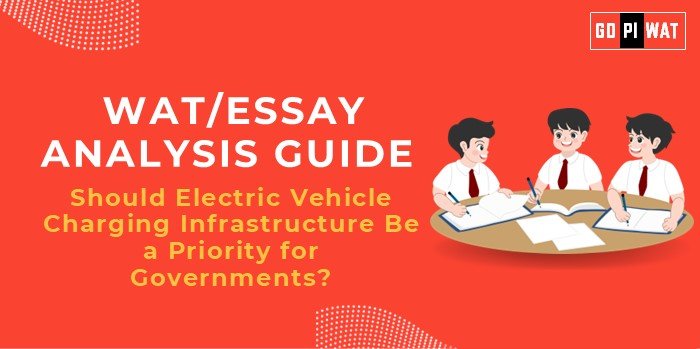📋 Written Ability Test (WAT) Analysis Guide
⚡ Should Electric Vehicle Charging Infrastructure Be a Priority for Governments?
🌍 Understanding the Topic’s Importance
EV infrastructure is not just about transportation; it represents a broader commitment to sustainable development, energy independence, and environmental preservation.
⏳ Effective Planning and Writing
- Time Allocation:
- Planning: 5 minutes
- Writing: 20 minutes
- Review: 5 minutes
- Preparation Tips:
- Note key EV statistics.
- Identify relevant stakeholders and global examples.
✍️ Introduction Techniques
- Contrast Introduction: “While EV adoption grows exponentially, the lack of charging infrastructure risks slowing progress toward climate goals.”
- Solution-Based Introduction: “Building robust charging infrastructure is the first step toward a clean, energy-efficient transportation future.”
📊 Structuring the Essay Body
- Achievements:
- EV incentives such as India’s FAME-II.
- International successes like Germany’s Autobahn chargers.
- Challenges with Comparative Analysis:
- High costs vs. long-term savings.
- Grid challenges in developing countries.
- Future Outlook:
- Smart charging solutions and renewable energy integration.
- Policies to encourage private-sector investment.
✅ Concluding Effectively
- Balanced Conclusion: “While EV infrastructure demands significant investments, its environmental and economic returns make it a necessity for governments.”
- Global Comparison Conclusion: “Countries like Norway and China exemplify how prioritizing EV infrastructure can accelerate the energy transition.”
📊 Analyzing Successes and Shortcomings
- Key Achievements: Expansion of EV use and renewable integration.
- Ongoing Challenges: Grid overload, uneven charger distribution.
💡 Recommendations for Sustainable Progress
- Develop public-private partnerships for cost-sharing.
- Incentivize renewable energy-driven charging stations.
- Focus on rural areas for equitable access.
📝 Sample Short Essays
- Balanced Perspective: “Governments must prioritize EV charging infrastructure to combat climate change but also ensure equitable access and renewable integration.”
- Solution-Oriented: “A phased approach to EV charging infrastructure, supported by public-private partnerships, will drive sustainable adoption.”
- Global Comparison: “Learning from Norway’s success, governments worldwide should focus on comprehensive EV infrastructure to enable a cleaner future.”


